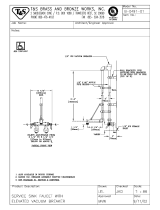INSTALLING THE INLET TUBING
When your planning is complete, you will have to determine
where all the inlets and the power unit will be located. You
have also mapped out the location of your trunk line and
found the access you need to run vertical tubing from one
level of your house to another level. You should have
acquainted yourself with the methods of joining plastic
tubing and acquired the tools you’ll need to install your
NuTone Central Vacuum System. Now, you can begin installation.
The first step to install the inlet tubing which connects the
wall inlets to the branch lines. As explained before, the inlet
lines run inside interior walls. You will find access to these
walls through your attic or basement. Briefly, you want to find
the exact location in the wall, drill an access hole through the
wall plate or header, and insert the tubing into the wall cavity.
This part of your installation requires close observation and
careful measurements. Take your time and make sure you
accurately line up your access holes with the locations
you’ve chosen for your wall inlets.
Locating Attic Access Holes
Drill the access holes directly above the inlet location.
To accurately locate the access hole, you must find the
space between wall studs where the inlet is to be located.
Observe the area around the inlet location. Look for
references you might be able to find in the attic: electrical
wiring, ductwork, doorways, etc. Measure and note the
distance from these references to the inlet location.
Enter the attic and find the inlet wall. Have a helper
downstairs knock on the top of the wall right above the inlet
location; locate the general area by following the sound.
Most likely, you will have to clear away insulation. Ask your
helper to continue knocking until you locate the area
between wall studs directly above the inlet location.
Next, measure the thickness of the wall. Mark the exact
center of the wall where you will drill the access hole.
Remember that the access hole must be placed exactly in
the center of the wall.
Locating Basement Access Holes
To locate access holes in the basement, remove the toe
molding or baseboard at the base of the inlet wall. Carefully
loosen the molding or baseboard by inserting the blade of a
putty knife behind it. Force another putty knife between the
first knife and the baseboard or wall. Gently hammer a cold
chisel between the two knife blades, prying the loosened
molding away from the baseboard or the baseboard away
from the wall.
Directly below the inlet location, drill a 1/16” reference hole
through the floor into the basement. (If you’re drilling through
carpet, use an awl to slightly open the weave. This will keep
the carpet from wrapping itself around the drill bit.) Insert a
piece of scrap wire or a clothes hanger into the reference
hole so you can easily find the hole in the basement.
Once you’ve found the location in the partition wall, you
must center the access hole in the middle of the wall.
Measure half the thickness of the wall and mark the
center of the wall where you will drill the access hole. If you
cannot see the plate, you can determine this measurement
from upstairs. At the nearest doorway, measure the
thickness of the wall, including the baseboard.
In the basement measure a distance equal to half the
thickness of the wall, using the reference hole as a starting point.
13





















